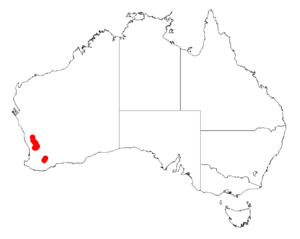Acacia trinalis facts for kids
Quick facts for kids Acacia trinalis |
|
|---|---|
| Conservation status | |
| Scientific classification | |
| Genus: |
Acacia
|
| Species: |
trinalis
|
 |
|
| Occurrence data from AVH | |
Acacia trinalis is a type of shrub or small tree. It belongs to the Acacia plant family. This plant is special because it only grows in one specific area: the southwestern part of Australia. When a plant or animal only lives in one place, it is called endemic.
What Does It Look Like?
This Acacia usually grows as a thick, rounded, and bushy shrub or a small tree. It can reach a height of about 1.5 to 4 meters (around 5 to 13 feet). It often has many stems growing from its base. The new branches are smooth (this is called glabrous) and have a sticky, tree sap-like substance called resin.
Like most Acacia species, Acacia trinalis doesn't have true leaves. Instead, it has special flattened leaf stems called phyllodes. These phyllodes are always green, smooth, and a bit leathery. They are long and narrow, usually straight or slightly curved. They measure about 4.5 to 9 centimeters (about 1.8 to 3.5 inches) long and 2 to 3 millimeters (about 0.08 to 0.12 inches) wide. Each phyllode has three raised lines, or "nerves," that also contain resin, with the middle nerve being the easiest to see.
This plant blooms in September, producing pretty yellow flowers. Its flowers grow in simple groups, usually in pairs, right where the phyllodes meet the stem (this spot is called the axil). Each flower group forms a small, round head, about 4 to 5 millimeters (0.16 to 0.2 inches) across. Each head contains 22 to 28 bright golden flowers.
Where Does It Grow?
Acacia trinalis is found naturally in the Wheatbelt region of Western Australia. It likes to grow in wet or damp places. You can often find it in swampy areas, near salt lakes, or on flat pieces of land. It grows well in sandy soils or soils that are a mix of clay and sand.
The area where this plant lives stretches from around a town called Marchagee in the northwest. It goes all the way down to the Mortlock River, which is close to the town of Goomalling in the southeast.


